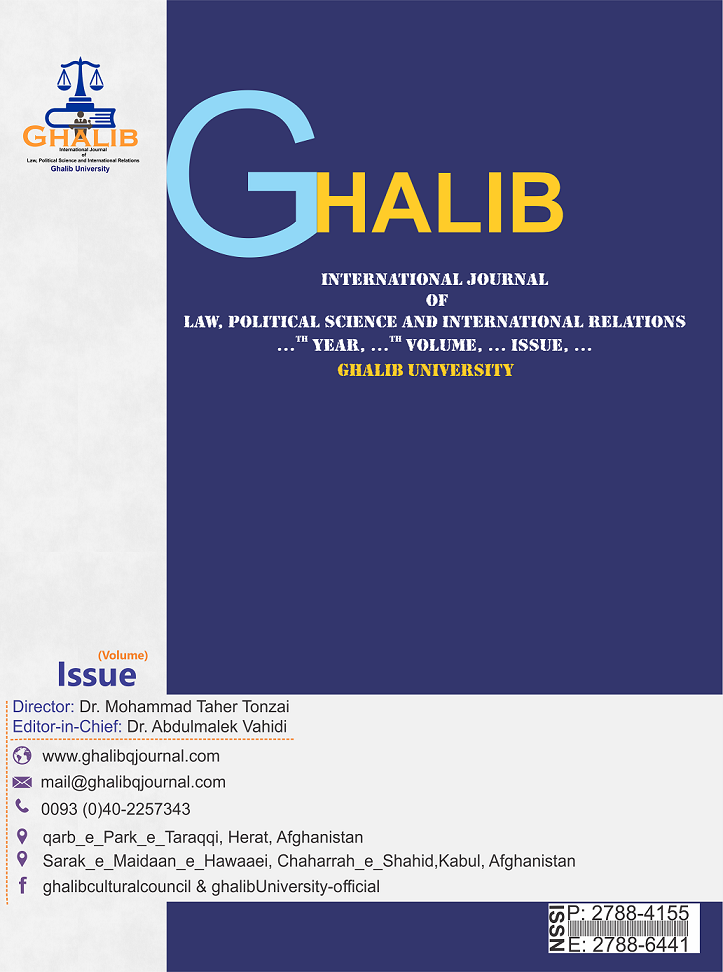Footprints of Shamanism in Afghanistan
DOI:
https://doi.org/10.58342/ghalibqj.V.12.I.3.6Keywords:
Shamanism, Afghanistan, Central Asia, Culture and Social HabitsAbstract
Shamanism is a set of beliefs and social traditions of ancient Turks, which includes religious beliefs, basic healing methods, stories about the world and its creation, customs and traditions in funerals, births and marriages, and other issues. Most of the beliefs in this belief system are influenced by the way of life of the Turks, and its roots go back to 20,000 years back. Despite the deep cultural changes among the Turks, including changing the religion several times and mixing with other cultures, shamanism has continued to be present in various forms. Until today, there are many shamanistic customs and habits among Muslim Turks and their close relatives, which includes Afghanistan and especially its northern parts. This article seeks to find traces of shamanistic beliefs and traditions in today's Afghan society. This search was done based on the objective observations of the author and in the light of the works that collected shamanistic beliefs under a single belief system. The scientific research that this study relies on is the works of Western, Turkish, and Persian-speaking researchers. Therefore, the method of this research is descriptive-analytical, and the method of comparing scientific findings about shamanism with existing social habits of the people of northern Afghanistan has also been used. The area under study is the research of the northern provinces of Afghanistan and especially the social customs of the people of Takhar Province in today's conditions. In this article, an attempt has been made to examine the historical and religious roots of many social beliefs and customs of the people of northern Afghanistan, which are mostly considered imaginary and unknown, and to determine their connection with ancient shamanistic beliefs.
References
آژانس خبری پژواک، (1 اسد 1402 ه ش)، «حکایت تلخِ موتر سوخته؛ در تخار، یک مرد بیش از سه دهه میشود در قبرستان قربانیان یک رویداد مرگبار زندهگی میکند». برداشت (2اسد 1402). قابل دسترس در: <https://pajhwok.com/fa/2023/07/23/the-bitter-story-of-burnt-car-in-takhar-a-man-has-been-living-in-the-cemetery-of-the-victims-of-a-deadly-event-for-more-than-three-decades/>.
استاتلی، مارگات. (1396). مقدمه¬ای بر شامانیسم. ترجمهٔ بیژن اسدیمقدم. ایران: نگین سبلان.
بارتولد، و. و. (1352). ترکستان¬نامه. ج اول. ترجمهٔ کریم کشاورز. ایران: بنیاد فرهنگ ایران.
4. عابدوف، داداجان. (1394)، آداب، آیینها و باورهای مردم افغانستان. کابل: انستیتیوت مطالعات استراتیژیک افغانستان.
مخبردزفولی، فهمیه. (1384). «ترکان از آیین شمنی تا اسلام». ایران: مجلهٔ علمی-پژوهشی تاریخ و تمدن اسلامی. شمارهٔ 1. صص. 49-69. <https://jhcin.srbiau.ac.ir/article_4832.html>.
نیکوبخت، ناصر؛ قاسمزاده، سیدعلی. (1388). «روشهای خلسهگی شمنیسم در برخی از فرقههای تصوف». ایران: مجلهٔ مطالعات عرفانی. (9). 185-216. https://sid.ir/paper/123357/fa>.
Davletov, Timur B. (2021), Sibirya’dan Anadolu’ya Türk Şamanizmi’nin Sosyolojisi, İstanbul: Urzeni Yayınevi.
Dupaigne, Bernard, (2013), “Shamans in Afghanistan”, Shamanism and Islam, Edu. Thierry Zarcone and Angela Hobart, London: I. B. Tauris and Co Ltd, 2013.
Ermetin, Günnur Yücekal, (2009), Mevlevilikte Şamanizm İzleri, İstanbul: Töre Yayınevi.
İnan, Abdülkadir, (1986) Tarihte ve Bugün Şamanizm, Ankara, Türk Tarih Kurumu.
İzgi, Mustafa Cumhur, (2012), “Şamanizm ve Şamanlara Genel bir Bakış”, Ankara: Lokman Hekim Journal, 2 (1).
İzgi, Özkan, (2020), Orta Asya Türk Tarihi Araştırmaları, Ankara: Türk Tarih Kurumu.
Mömin, Samire, (2013), “Şamanizm ve Günümüzdeki Kalıntıları”, Ankara: Ulakbilge Dergisi, c. 1, sayı 1, (79-89).
Roux, Jean-Paul, (2001), Orta Asya Tarih ve Uygarlık, İstanbul: Kabalcı Yayınevi.
Sultanova, Razia, (2011), From Shamanism to Sufism, Women, Islam and Culture in Central Asia, London: I. B. Tauris and Co Ltd.
References
Abedov, Dadajan, (2014), Manners, Rituals and Beliefs of the People of Afghanistan, Kabul: Institute of Strategic Studies of Afghanistan. (Persian)
Davletov, Timur B. (2021), Sociology of Turkish Shamanism from Siberia to Anatolia, Istanbul: Urzeni. (Turkish)
Dupaigne, Bernard, (2013), “Shamans in Afghanistan”, Shamanism and Islam, Edu. Thierry Zarcone and Angela Hobart, London: I. B. Tauris and Co Ltd, 2013. (English)
Ermetin, Günnur Yücekal, (2009), Traces of Shamanism in Mevlevi, Istanbul: Töre. (Turkish)
Inan, Abdulkadir, (1986) Shamanism in History and Today, Ankara, Turkish Historical Society. (Turkish)
İzgi, Mustafa Cumhur, (2012), “Shamanism and an Overview of Shamans”, Ankara: Lokman Hekim Journal, 2 (1). (Turkish)
İzgi, Özkan, (2020), Central Asian Turkish History Studies, Ankara: Turkish Historical Society. (Turkish)
Mokhbardzfouli, Fahmieh, (Summer 2014), "Turks from Shamanism to Islam", Scientific Research Journal of Islamic History and Civilization, No. 1, pp. 49-69. (Persian)
Mömin, Samire, (2013), “Shamanism and Its Remains Today”, Ankara: Ulakbilge Journal, V. 1, number 1, (79-89). (Turkish).
Nikobakht, Nasser and Qasim-zadeh, Seyyed Ali, (spring and summer 2018), "The ecstatic methods of shamanism in some sects of Sufism", Esfani Studies, No. 9, pp. 185-216. (Persian)
Pajhwok News Agency, (1 Asad 1402 AH), "The bitter story of "burnt car" in Takhar; For more than three decades, a man lives in the cemetery of the victims of a fatal event", https://pajhwok.com/fa/2023/07/23/the-bitter-story-of-burnt-car-in-takhar-a -man-has-been-living-in-the-cemetery-of-the-victims-of-a-deadly-event-for-more-than-three-decades/ (Persian)
Roux, Jean-Paul, (2001), Central Asian History and Civilization, Istanbul: Kabalcı. (Turkish)
Statley, Margat, (2016), an introduction to shamanism, translated by Bijan Asadi Moghadam, Negin Sablan.
Sultanova, Razia, (2011), From Shamanism to Sufism, Women, Islam and Culture in Central Asia, London: I. B. Tauris and Co Ltd. (English)
Barthold, V. V. (1352), Turkestannameh, first volume, translated by Karim Keshavarz, Iran: Foundation of Iran Farhang.
Downloads
Published
How to Cite
Issue
Section
License
Copyright (c) 2023 ghalib quarterly journal

This work is licensed under a Creative Commons Attribution 4.0 International License.













